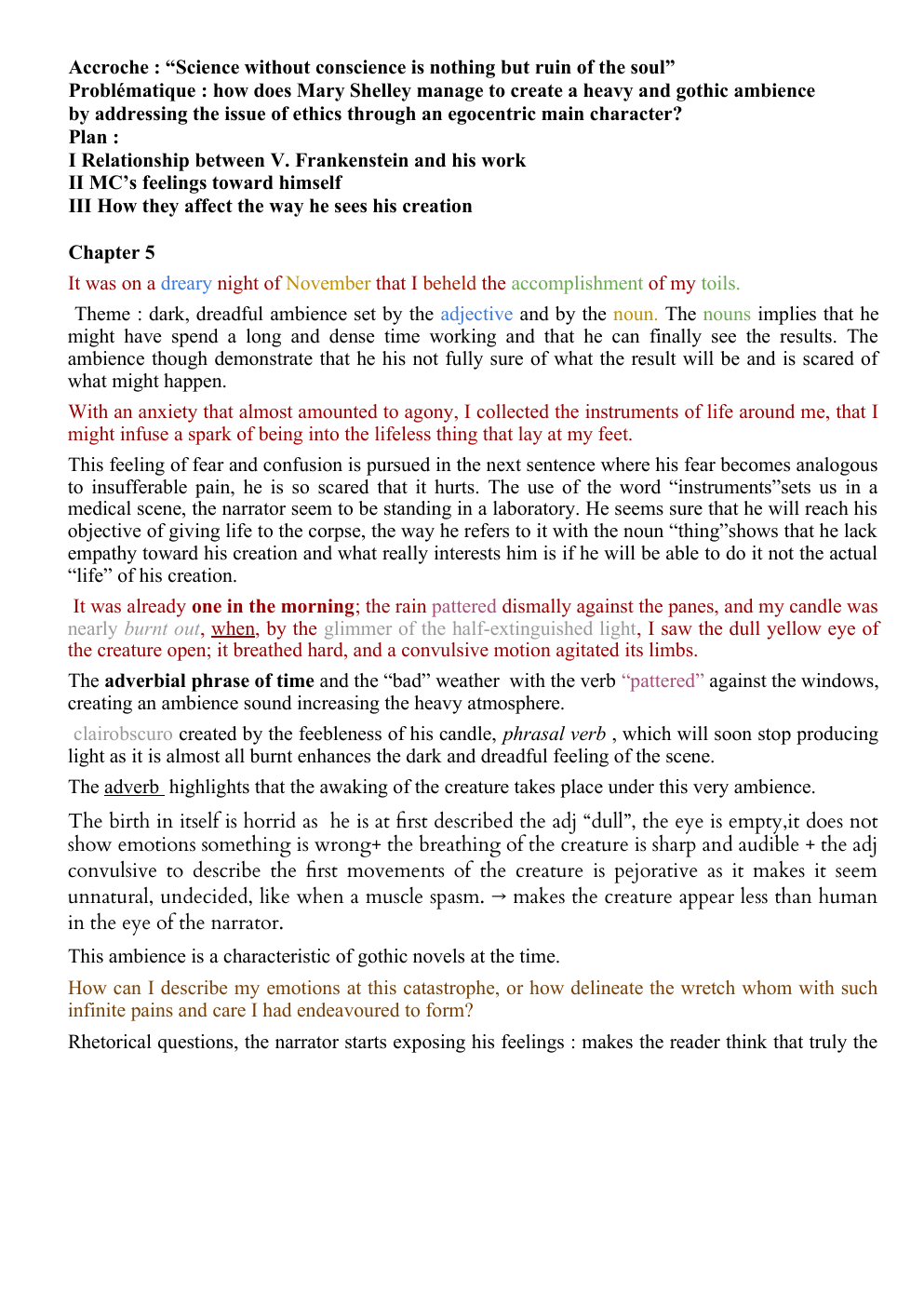explication littéraire Chap 5 Frankenstein M.Shelley en anglais
Publié le 02/10/2025
Extrait du document
«
Accroche : “Science without conscience is nothing but ruin of the soul”
Problématique : how does Mary Shelley manage to create a heavy and gothic ambience
by addressing the issue of ethics through an egocentric main character?
Plan :
I Relationship between V.
Frankenstein and his work
II MC’s feelings toward himself
III How they affect the way he sees his creation
Chapter 5
It was on a dreary night of November that I beheld the accomplishment of my toils.
Theme : dark, dreadful ambience set by the adjective and by the noun.
The nouns implies that he
might have spend a long and dense time working and that he can finally see the results.
The
ambience though demonstrate that he his not fully sure of what the result will be and is scared of
what might happen.
With an anxiety that almost amounted to agony, I collected the instruments of life around me, that I
might infuse a spark of being into the lifeless thing that lay at my feet.
This feeling of fear and confusion is pursued in the next sentence where his fear becomes analogous
to insufferable pain, he is so scared that it hurts.
The use of the word “instruments”sets us in a
medical scene, the narrator seem to be standing in a laboratory.
He seems sure that he will reach his
objective of giving life to the corpse, the way he refers to it with the noun “thing”shows that he lack
empathy toward his creation and what really interests him is if he will be able to do it not the actual
“life” of his creation.
It was already one in the morning; the rain pattered dismally against the panes, and my candle was
nearly burnt out, when, by the glimmer of the half-extinguished light, I saw the dull yellow eye of
the creature open; it breathed hard, and a convulsive motion agitated its limbs.
The adverbial phrase of time and the “bad” weather with the verb “pattered” against the windows,
creating an ambience sound increasing the heavy atmosphere.
clairobscuro created by the feebleness of his candle, phrasal verb , which will soon stop producing
light as it is almost all burnt enhances the dark and dreadful feeling of the scene.
The adverb highlights that the awaking of the creature takes place under this very ambience.
The birth in itself is horrid as he is at first described the adj “dull”, the eye is empty,it does not
show emotions something is wrong+ the breathing of the creature is sharp and audible + the adj
convulsive to describe the first movements of the creature is pejorative as it makes it seem
unnatural, undecided, like when a muscle spasm.
→ makes the creature appear less than human
in the eye of the narrator.
This ambience is a characteristic of gothic novels at the time.
How can I describe my emotions at this catastrophe, or how delineate the wretch whom with such
infinite pains and care I had endeavoured to form?
Rhetorical questions, the narrator starts exposing his feelings : makes the reader think that truly the
experiment did not go as planned.
The narrator is confused about how he should feel about his
creation, the noun “catastrophe” implies the failure of the scientist.
He does not know how to “define” the thing he has created, he calls it a “wretch” → for him it’s
a failure
The hyperbole “infinite pain and care” → the narrator seems to have put a lot of effort in this
experiment, he exaggerates his feelings,maybe to make us feel pity toward him.
The
intransitive verb + prep = he has put a lot of work in his creation, he is devastated that he failed
to create something human
His limbs were in proportion, and I had selected his features as beautiful.
Beautiful! Great God!
(victor finally realises what he did) His yellow skin scarcely covered the work of muscles and
arteries beneath; his hair was of a lustrous black, and flowing; his teeth of a pearly whiteness; but
these luxuriances only formed a more horrid contrast with his watery eyes, that seemed almost of
the same colour as the dun-white sockets in which they were set, his shrivelled complexion and
straight black lips.
Victor Frankenstein, the narrator then describes the appearance of his creation, at first he says
that he is beautiful, that he selected parts of body so that it would be beautiful, proportional →
he intended to create a handsome human not a monster.
Yet he continues by saying that the skin of the creature is yellow → inhuman colour, he speaks
about the organs in the body, hidden by the yellow skin → makes us think that his skin is here
only to hide whats underneath, to make it appear human, but failing by it’s colour.
But the
adjectives he uses to talk about his hair and teeth are positive → despite its weird skin the
creature has beautiful hair and “pure- looking” teeth.
We can notice that he still puts a stop to
the beauty of the creature with the adj “horrid” → yes it has beautiful features but it is not
human, it is still a creature.
Watery eyes +“dun-white sockets”+shrivelled complexion”+ “straight black lips”= the unnatural
colours and weird shape and texture of his skin makes....
»
↓↓↓ APERÇU DU DOCUMENT ↓↓↓
Liens utiles
- Frankenstein de Mary Shelley
- commentaire littéraire Chap 2, Supplément au voyage de bougainville, Diderot
- LES TRAGIQUES Livre Premier : Misères AGRIPPA D'AUBIGNÉ v. 1271-1300 (Explication littéraire)
- Explication de l'extrait d'aristote Ethique à Nicomaque Livre IX Chap 4 1166 a-b
- L'oeuvre n'est pas une série de réponses, elle est une série de questions, elle n'est pas des explications, elle est des demandes d'explication, des demandes d'éclaircissement... C'est bien cela une oeuvre: une série d'interrogations... Au bout du compte, il n'y a pas de réponse à donner... Ainsi, ce n'est pas la réponse qui éclaire, c'est la question. Commentez librement cette réflexion d'Eugène Ionesco sur la fonction de l'oeuvre littéraire, en vous servant d'exemples précis.


